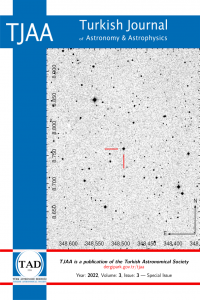Abstract
In stellar evolution calculations, a well-known problem in comparing observed and model-calculated frequencies comes from the hard-to-model near-surface layers of stars. Models usually employ simplified model atmospheres, and mixing length theory is used to describe convection which leads to errors in the structure of the superadiabatic region. Moreover, model oscillation frequencies calculated in the usual adiabatic approximation neglect the effects of turbulent pressure.
Convection in the superadiabatic region is commanly treated with the mixing length theory (MLT). However, as a result of non-local non-linear nature of surface convection, MLT cannot correctly model this complex region. The upper boundary conditions near the optical surface do not agree with asteroseismic observations. This is reflected in asteroseismology as so-called near-surface effects, when stellar sturcture models are compared with p-mode oscillation frequencies. Therefore,
we want also to improve how the outher boundary conditions are determined in stellar structure calculations. We study realistic 3D stellar atmosphere models. We precisely match stellar models to the effective temperature, the gravity at the photosphere, and the temperature at the temporally and horizantally averaged pressure at deepest point of the 3D simulations. We then replace the near-surface structure with that of the averaged simulation and compute the change in
the oscillation mode frequencies.
References
- Asplund M., Grevesse N., Sauval A. J., Scott P., 2009, ARA&A, 47,481
- Beeck B., Cameron R. H., Reiners A., Schüssler M., 2013, A&A, 558, A48
- Böhm-Vitense E., 1958, Z. Astrophys., 46, 108, ADS
- Borucki W. J., et al., 2010, Science, 327, 977
- Broomhall A.-M., Chaplin W. J., Davies G. R., Elsworth Y., Fletcher S. T., Hale S. J., Miller B., New R., 2009, MNRAS, 396, L100
- Christensen-Dalsgaard J., 2011, ADIPLS: Aarhus Adiabatic Oscillation Package (ADIPACK), Astrophysics Source Code Library (ascl:1109.002)
- Christensen-Dalsgaard J., Thompson M. J., 1997, MNRAS, 284, 527
- Christensen-Dalsgaard J., et al., 1996, Science, 272, 1286
- Freytag B., Steffen M., Ludwig H.-G., Wedemeyer-Böhm S., Schaffenberger W., Steiner O., 2012, Journal of Computational Physics, 231, 919
Abstract
Yıldız evrim hesaplamalarında, gözlem ile modelden hesaplanmıs teorik frekansların karsılastırılmasında en iyi bilinen problem yıldızların yüzey-yakın katmanlarının modelleme zorlugundan kaynaklanır. Modeller genelde basitlestirilmis model atmosferlerini ve, süperadibatik bölge yapısında hatalara sebep olan konveksiyon tanımında, karısım uzunlugu teorisini kullanır. Dahası, genel adyabatik yaklasımda hesaplanan model salınım frekansları türbülant basınç etkilerini ihmal eder. Süper adyabatik bölgede konveksiyon genelde karısım uzunlugu teorisi (MLT) ile ele alınır. Fakat, yüzey konveksiyonunun lokal-olmayan ve lineer-olmayan dogasının bir sonucu olarak, MLT bu karısık bölgeyi dogru bir sekilde modelleyemez. Optik yüzeye yakın üst sınır kosulları asterosismik gözlemler ile uyusmaz. Yıldız yapı modelleri p-mod salınımları ile karsılastırıldığı zaman, bu asterosismolojiye sözde yüzey-yakın etkileri olarak yansır. Sonuç olarak, yıldız yapı hesaplamalarında üst sınır kosullarının nasıl belirlendigini iyilestirmek istiyoruz. Biz gerçek 3D yıldız atmosfer modellerini çalısıyoruz. Bunun için hassas bir sekilde yıldız modellerini fotosferik etkin sıcaklık ve çekime ve 3D simülasyonlarının en derin noktasında zamansal ve yataysal olarak ortalanmıs basınçtaki sıcaklık değerine eşleştiriyoruz. Daha sonra yakın-yüzey yapısını bu ortalanmış simülasyon ile yer değiştirip mod frekanslarındaki değisimi hesaplıyoruz.
References
- Asplund M., Grevesse N., Sauval A. J., Scott P., 2009, ARA&A, 47,481
- Beeck B., Cameron R. H., Reiners A., Schüssler M., 2013, A&A, 558, A48
- Böhm-Vitense E., 1958, Z. Astrophys., 46, 108, ADS
- Borucki W. J., et al., 2010, Science, 327, 977
- Broomhall A.-M., Chaplin W. J., Davies G. R., Elsworth Y., Fletcher S. T., Hale S. J., Miller B., New R., 2009, MNRAS, 396, L100
- Christensen-Dalsgaard J., 2011, ADIPLS: Aarhus Adiabatic Oscillation Package (ADIPACK), Astrophysics Source Code Library (ascl:1109.002)
- Christensen-Dalsgaard J., Thompson M. J., 1997, MNRAS, 284, 527
- Christensen-Dalsgaard J., et al., 1996, Science, 272, 1286
- Freytag B., Steffen M., Ludwig H.-G., Wedemeyer-Böhm S., Schaffenberger W., Steiner O., 2012, Journal of Computational Physics, 231, 919
Details
| Primary Language | Turkish |
|---|---|
| Subjects | Astronomical Sciences (Other) |
| Journal Section | Conference Paper |
| Authors | |
| Publication Date | December 31, 2022 |
| Submission Date | April 12, 2022 |
| Acceptance Date | May 13, 2022 |
| Published in Issue | Year 2022 Volume: 3 Issue: 3 |
TJAA is a publication of Turkish Astronomical Society (TAD).


